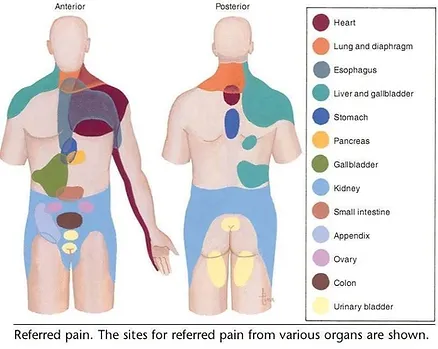Visceral referred pain (VRP) is pain created in the body in reference to organs having problems.
The reason this can happen is because during the embryo phase of development the somatic and musculoskeletal structures can share the same origin. When this happens they share the same sentimental levels during development and will continue to share them once fully developed
A very common one people are used to hearing is during a heart attack feeling pain shoot down your left arm on the ulnar side. This is because the heart is under attack. Someone having problems with breathing/diaphragm can feel neck pain on the left side.
How to identify this:
Pain will often feel dull and diffuse, but can often turn sharp when things get worse.
Often will have other issues with referred organ
Visceral Parietal Pain:
While visceral referred pain is felt elsewhere than the origin, visceral parietal pain (VPP) is felt over the organ itself. Abdominal organs don't have pain receptors on the inner most portion of them. However, as we move further out towards the capsular covering and surrounding tissue of an organ these can sense fast nociception, also known as sharp pain.
We usually find VPP's more with hollow organs like the stomach and small/large intestine. This is because the pain receptors are stimulated when there is movement or expansion such as food passing through the stomach and small/large intesting or a bladder filling with urine.
What can P-DTR do the help Visceral Referred and Parietal Pain?
Proprioceptive-Deep Tendon Reflex is a technique geared towards understanding how the nervous system is interpreting stimuli and producing a response. If the information coming is in bad, then the information going out will also be dysfunctional.
Visceral Referred Pain & Visceral Parietal Pain
P-DTR assesses for excessive sympathetic or parasympathetic stimulus going to organs as well as checking the capsular covering of the organs. From there we can help to re-calibrate the body and update the nervous system to help return these organs to a better state of homeostasis.

Indirectly: Emotional Work
When people are exposed to stressful situations or trauma it can create an emotional dysfunctions that are hard to process. The first things the emotional issue will do is find a way to compensate and that is usually organs. In simple terms it means that its a lot easier to be constipated or have a upset stomach than to have the trauma/stressors keep popping into your mind.
Schedule Your Bodywork Session Today:
Learn more about P-DTR here:











Comentários